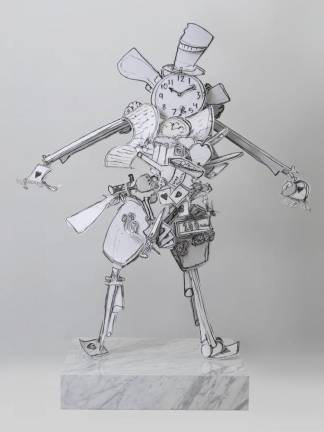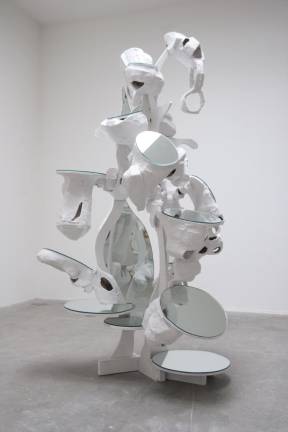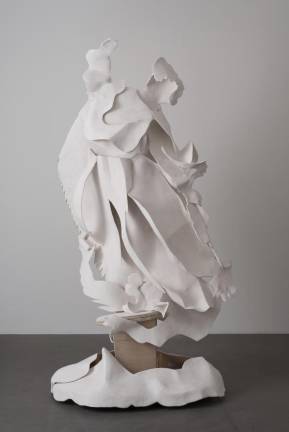One Woman’s Vision of Women
Rachel Feinstein’s unpredictable and intriguing works are on dazzling display at the Jewish Museum



By Virge Randall
“Maiden, Mother, Crone” is an idiosyncratic tour of the roles of women as envisioned by the highly original Rachel Feinstein, executed in 35 works of paint, sculpture, maquettes and video.
Based on the three major stages in women’s lives, the exhibit at the Jewish Museum is an adventurous mashup of literal cutting-edge sensibility (Feinstein used a chainsaw to create Picasso-like freestanding wood sculptures), draftsmanship, and references to the Italian Baroque period, Regency England, the Bible and more (she studied art history and religion at Columbia).
Curated by Kelly Taxter, the Barnett and Annalee Newman Curator of Contemporary Art at the Jewish Museum, the show, just in time for Women’s History Month in March, surveys three decades of Feinstein’s art, with its unpredictable and always intriguing techniques, influences, subjects and style.
The tone is set at the entrance, where you are greeted by three larger-than-life statues in wood and canvas, each with very different subtexts. On either side are impressionistic statues of Christian saints – St. Sebastian, martyred with arrows, and St. Michael, surrounded in drapery that a Baroque sculptor like Bernini would love (he’s among her influences).
Front and center is a strangely twisted tree, each branch ending with a mirror. As an artist who modelled since her teens, Feinstein drew inspiration from her experience and observations about appearance and identity. Her explorations of beauty, time, art, and femininity echo throughout the exhibit.
The show balances the whimsical and the serious, the imaginative and the historical, the austere and the exuberant. Feinstein’s antennae is set on “high” to receive many different influences, from drawings by her son (like the exuberant “Mr. Time”) to her time in Miami. “Goldstein,” a 40-foot wall relief work, commissioned by the Jewish Museum, executed in white enameled wood, features a Miami-ish villa with a fancy car parked in front.
The mood shifts dramatically with a searing “Crucifixion,” created after 9/11, which Feinstein witnessed from her apartment window. Here, she gives traditional imagery immediacy and power by stripping it of all color, using only form – canvas and wood. Christ is angular and twisted in agony, the three figures below – Mary, Mary Magdalene and St. John – crouch in attitudes of grief, despair and shock.
The Crones in this show – five paintings on oval mirrors of elderly women in the towering wigs, hats and finery of Regency attire – are an engaging bunch of characters, painted in grays and whites: Eileen, awaiting some juicy gossip; Ruth, daintily sipping her tea; Eva, the impatient grande dame; Rhoda, the cheerful neighbor; and Marie, protectively guarding a baby deer. It feels like Feinstein knows these women – but she hired a casting director and professionals to find, dress, make up, light and photograph them all. Feinstein created the paintings just after she had given birth, while she was working on a fashion ad campaign. She confessed that she felt strange in her own skin and perhaps was looking toward the last major stage in a woman’s life.
The sculptures – a mix of plain wood and brightly (even garishly) painted statues that embody Maidens and Mothers – are the stars of the exhibit. Flat yet dimensional, “Adam and Eve” captures the intricate balance of an entwined male and female figure near a lush tree. Feinstein skillfully uses positive and negative space for her narrative – Eve’s hand pokes through the foliage, holding an apple to offer to Adam.
“Mother and Child,” made of wood, has a Picasso flavor in its three dimensions. Mother has a huge, stylized ear attuned to the babe in arms, and the child is all wide-open mouth, either crying or hungry. In contrast, “Girl” seems positively sedate, a figure rendered in plain wood, featureless and elongated, like something by Elie Nadelman (another Feinstein influence). And then there’s “The Bird Girl,” a sculpture of a Caribbean woman, brightly painted, like a carnivale celebrant, surrounded by the birds she feeds, which are whimsically fashioned like stop action figures, including a bug-eyed bluebird.
The second room is dominated by “Panorama of Rome,” painted on Mylar and covering every wall. The baroque-inspired work, in black, gray and white, with touches of maroon, gives a sense of place and mood – walking through this room feels like walking through a sculpture garden.
The standouts here include “Butterfly,” a gaily painted statue of a sassy gal in bra, panties and garter belt, with high heeled peekaboo boots, blowing a kiss to a butterfly. And “Bleeding Shepherdess” is a perfectly executed spin on a classic trope: the hatted, beribboned shepherd girl, holding a lamb, her frilly skirts blowing in the wind – and bloodstained at the bottom because she got her period.